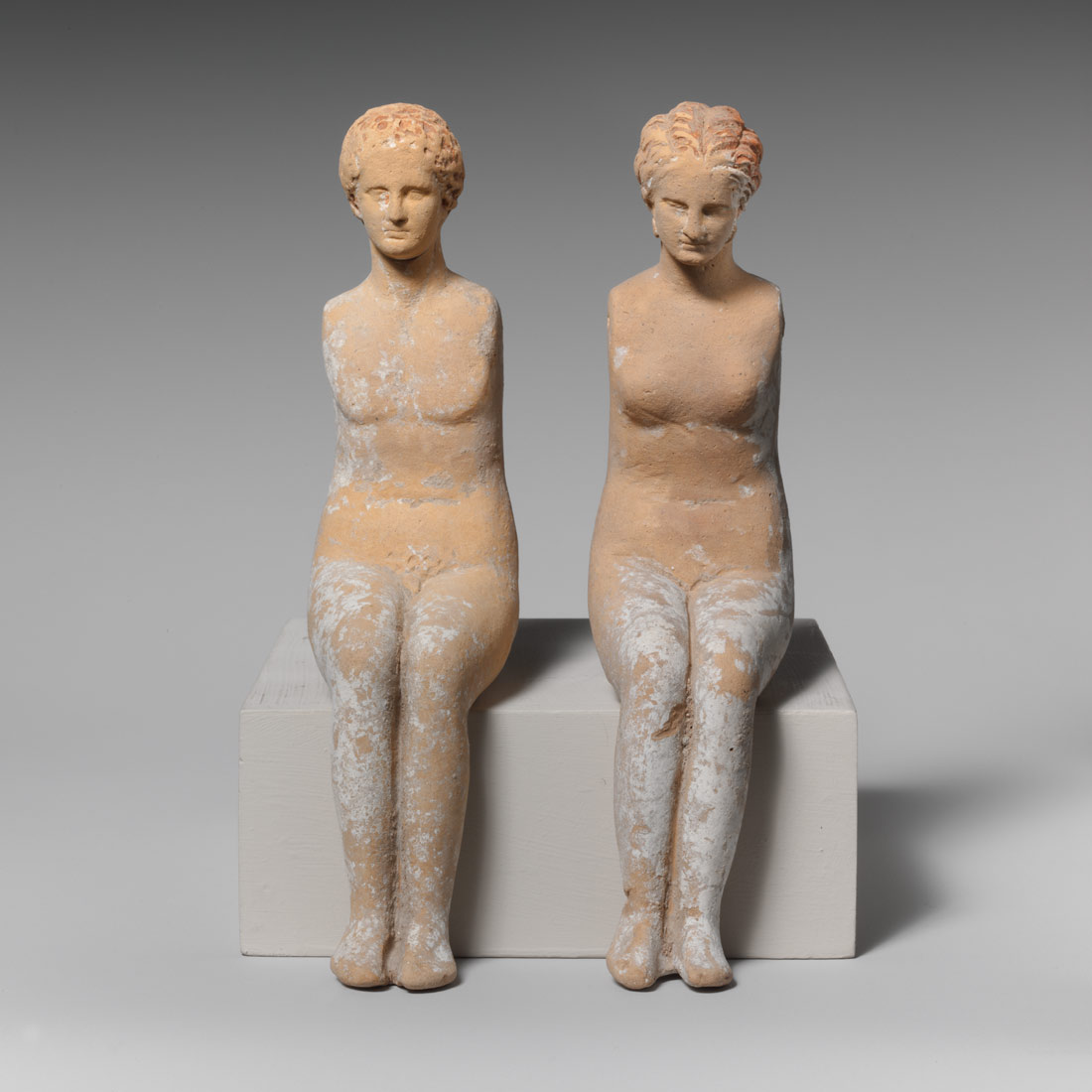read the following article, then with the clay provided create your own Terracotta Figurine with Articulated Limbs
Greek Terracotta Figurines with Articulated Limbs
Terracotta standing male figurine holding a quadruped, ca. 750-600 B.C., Cypriot (74.51.1613); Terracotta standing warrior (?), ca. 750-600 B.C., Cypriot (74.51.1614); Terracotta standing warrior with a shield, ca. 750-600 B.C., Cypriot (74.51.1655); Terracotta standing male figurine playing a double flute, ca. 750-600 B.C., Cypriot (74.51.1691); Terracotta standing male figurine, ca. 750-600 B.C., Cypriot (74.51.1692)
![Terracotta standing statuettes with warriors and males [Cypriot; Said to be from a tomb at Ormidhia] Terracotta standing statuettes with warriors and males [Cypriot; Said to be from a tomb at Ormidhia]](http://www.metmuseum.org/toah/images/ht/ht_74.51.1655,14,13,91,92.jpg)
Fragmentary terracotta pinax (plaque) with a dancing girl, 5th century B.C., Cretan (53.5.39)
![Fragmentary terracotta pinax (plaque) with a dancing girl [Cretan; Excavated in Praisos] Fragmentary terracotta pinax (plaque) with a dancing girl [Cretan; Excavated in Praisos]](http://www.metmuseum.org/toah/images/ht/ht_53.5.39.jpg)
![Terracotta figurine with articulated arms and legs [Greek, Corinthian] Terracotta figurine with articulated arms and legs [Greek, Corinthian]](http://www.metmuseum.org/toah/images/ht/ht_44.11.8.jpg)
Terracotta statuette of a seated youth with articulated arms, late 4th-early 3rd century B.C., Greek, Boeotian; Said to be from Thebes, Purchase, 1901 (01.13.1); Terracotta statuette of a seated girl with articulated arms, late 4th-early 3rd century B.C., Greek, Boeotian (01.13.2)
![Terracotta statuettes of seated youths with articulated arms [Greek, Boeotian; Said to be from Thebes] Terracotta statuettes of seated youths with articulated arms [Greek, Boeotian; Said to be from Thebes]](http://www.metmuseum.org/toah/images/ht/ht_01.13.1,2.jpg)
![Bone figurine with articulated arms and legs [Greek; Said to be from Tarentum] Bone figurine with articulated arms and legs [Greek; Said to be from Tarentum]](http://www.metmuseum.org/toah/images/ht/ht_11.212.43.jpg)
Terracotta figurines were rather familiar objects to the ancient Greeks. Fragments and complete pieces found in the course of archaeological excavations form the primary basis for our understanding of how the figurines were used. They stood in houses as mere decorations, or served as cult images in small house shrines; some of them functioned as charms to ward off evil. They were brought to
temples and sanctuaries as
offerings to the gods and deposited in
graves either as cherished possessions of the deceased, as gifts, or as protective device
Among the numerous types of Greek terracotta figurines, one group stands out. These are figurines with jointed or movable limbs; this means that their legs, arms (
01.13.1,2), and sometimes even heads were made separately and attached to the body after firing. Statuettes of this type represent a class common all over the Greek and Roman world during all periods. Such figurines existed in Greece as early as the tenth century
B.C., were widely popular in
Cyprus from the eighth century
B.C. onward (
74.51.1655,14,13,91,92), and continued down through the
Roman period. The vast majority of these figurines have suspension holes on top of their heads; the dangling arms and legs were in motion when the figurines were shaken or hung. The movement of the limbs certainly lent vitality to a figurine, while adding a magical aspect.
Terracotta figurines with articulated limbs are often described as dolls or children's toys, and are sometimes thought to have been dressed in clothes. While one cannot simply dismiss these assumptions, it must be pointed out that this hypothesis is based on an inaccurate reading of an ancient epigram, which was originally interpreted to say that a girl named Timareta dedicated to the goddess (at a sanctuary) her dolls and their dresses. However, more recently it has been convincingly argued that she in fact dedicated her hair and her own clothing. Another point to be made against the figurines being play things is that they are too fragile (11.212.43) to be constantly handled by children. The fact that these "dolls" are often discovered in the graves of adults indicates their possible chthonic connection or apotropaic function. In addition, the movement these figurines were capable of when swinging, as well as the clanking noise they produced, might have made them attractive charms.
Given so many choices, it is rather difficult to define a single purpose for the articulated figurines. The fact that they could move would seem to be essential to understanding their function and meaning, which have not been satisfactorily explained thus far.
Maya B. Muratov Bothmer Fellow, Department of Greek and Roman Art, The Metropolitan Museum of Art
guidelines for you terracotta project
x: must have at least one removable limb or head
x: must be at least 6 inches tall
x: must come with a write up telling me what your figures purpose is
x: must be able to be fired in the kiln, if it blows up you will need to make another

![Terracotta standing statuettes with warriors and males [Cypriot; Said to be from a tomb at Ormidhia] Terracotta standing statuettes with warriors and males [Cypriot; Said to be from a tomb at Ormidhia]](http://www.metmuseum.org/toah/images/ht/ht_74.51.1655,14,13,91,92.jpg)

![Fragmentary terracotta pinax (plaque) with a dancing girl [Cretan; Excavated in Praisos] Fragmentary terracotta pinax (plaque) with a dancing girl [Cretan; Excavated in Praisos]](http://www.metmuseum.org/toah/images/ht/ht_53.5.39.jpg)
![Terracotta figurine with articulated arms and legs [Greek, Corinthian] Terracotta figurine with articulated arms and legs [Greek, Corinthian]](http://www.metmuseum.org/toah/images/ht/ht_44.11.8.jpg)

![Terracotta statuettes of seated youths with articulated arms [Greek, Boeotian; Said to be from Thebes] Terracotta statuettes of seated youths with articulated arms [Greek, Boeotian; Said to be from Thebes]](http://www.metmuseum.org/toah/images/ht/ht_01.13.1,2.jpg)
![Bone figurine with articulated arms and legs [Greek; Said to be from Tarentum] Bone figurine with articulated arms and legs [Greek; Said to be from Tarentum]](http://www.metmuseum.org/toah/images/ht/ht_11.212.43.jpg)